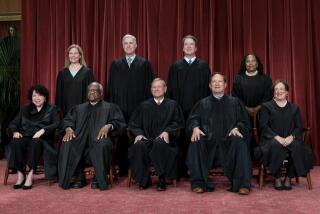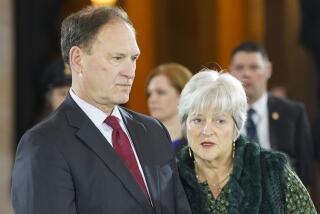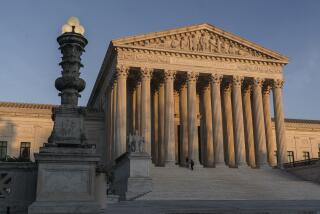‘Tale of Two Justices’
- Share via
Every once in a while The Times prints an editorial that has good intentions but is misguided both in its assumptions and conclusions.
Your “Tale of Two Justices” is a good example. In it you advocate Justice Rehnquist’s confirmation as chief justice of the United States and California Chief Justice Bird’s retention for essentially the same reason--that we should approach the judiciary without an unfounded desire to change the American judicial tradition. Yours is an admirable view, but it is not sound with respect to Chief Justice Bird, for several reasons:
1--You cited Alexander Hamilton in the Federalist to underscore the importance of judicial independence. Unless the Federalist has been recently revised, however, Hamilton was referring to the federal, not state , courts. Hamilton also wrote his works well before anyone ever dreamt of the possibility of judicial activism in our courts.
When Chief Justice Bird consistently drives her views on the death penalty, the felony murder rule, and strict tort liability, among others, it is arguably Bird who is upsetting the apple cart in California’s legal system, not the Legislature or executive branch. Bird is not being judicially independent.
2--The argument that politics should not enter the picture in the decision whether or not to retain Chief Justice Bird makes no sense in California. Before the 20th Century, the California judiciary election was as purely political as any political office we elect today. The referendum establishing the current retention-election system for the California Supreme Court in the early 1930s--was a compromise between California’s early judicial election system and the concept of judicial independence.
Obviously, if it were truly desired that politics be entirely ignored in California’s judicial choices there would be no retention-election in California. (It should also be noted that former Gov. Edmund G. Brown Jr.’s selection of Bird in 1977 was as political or more political than any anti-Bird stance today.) Therefore, a vote against Bird based simply on her politics as she uses her politics in her decisions would be well within the judicial “custom and tradition” in California.
3--Unlike your editorial, I do not feel Chief Justice Bird is “within America’s judicial tradition” or “an ardent apostle of reform.” The great judicial activist/reform courts in California, New Jersey and the District of Columbia were great because they discarded many horribly obsolete and cruel legal doctrines that had tended to work against the poor or uneducated in our society. The changes made were extremely popular and well received among the jurisdictions adopting the reforms. What Chief Justice Bird has done, however, is to defy both the California Legislature and popular opinion on extremely important issues in the law. Her stances have effected a step backward, not forward, in California’s legal tradition, and severely damaged the prestige and effectiveness of the California Supreme Court.
Perhaps the same sort of arguments could be advanced against Justice Rehnquist. Personally, I feel Rehnquist has assets Bird will never have--experience, remarkably effective advocacy skills even with unpopular stances, and the respect of most of those opposed to him. But his story is not Bird’s story, and the two should not be equated, as The Times did.
PAUL L. ALPERN
Long Beach


